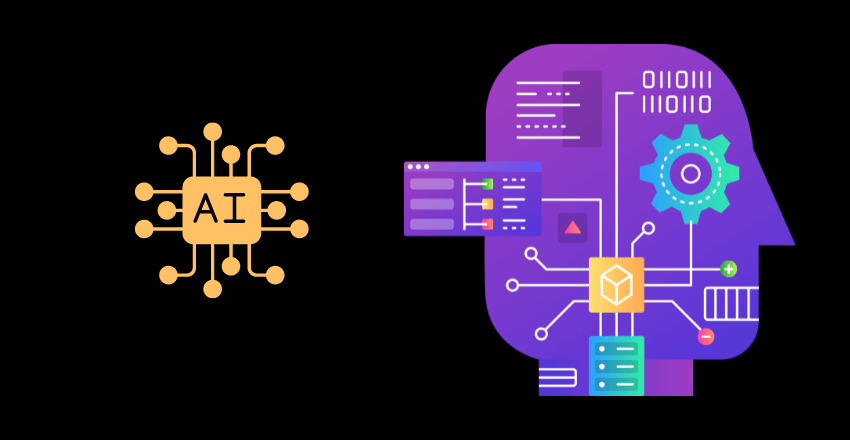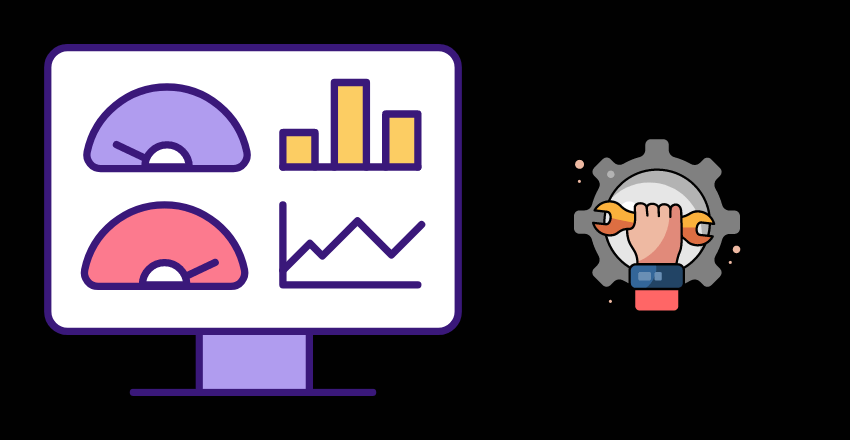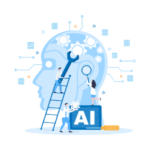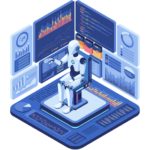 How to Create AI Business Applications seamlessly: Discover methods to blend AI with your business strategies, enhancing customer experiences, optimizing operations, and gaining a competitive edge in the market.
How to Create AI Business Applications seamlessly: Discover methods to blend AI with your business strategies, enhancing customer experiences, optimizing operations, and gaining a competitive edge in the market.
Artificial intelligence (AI) has been a game-changer in the business world, transforming the way companies operate and compete. Building AI business apps can help enterprises automate processes, increase efficiency, and enhance decision-making, among other benefits.
Key Takeaways:
- Building AI business apps can help automate processes and increase efficiency in various industries.
- Creating an effective AI business application requires understanding your business’s needs and goals.
- Selecting the right AI technologies, gathering and preparing data, and monitoring and maintaining the application are all critical steps in the process.
Understanding the Role of AI in Business
In recent years, artificial intelligence (AI) has become an increasingly popular topic in the business world. From building AI business apps to implementing AI in business software, enterprises of all sizes are recognizing the potential benefits of incorporating AI into their operations.
But what is AI, and why is it so important for businesses? Put simply, AI refers to the development of computer systems that can perform tasks that typically require human intelligence, such as learning, problem-solving, and decision-making.
By automating these processes, businesses can improve efficiency, reduce costs, and gain valuable insights into their operations.
AI can have a significant impact on a wide range of industries, from healthcare and finance to manufacturing and transportation. By enabling businesses to analyze vast amounts of data and make predictions based on that data, AI can help them identify opportunities for growth and innovation.
Building AI Business Apps
One of the most common ways for businesses to take advantage of AI is by building AI business apps. These applications can be used to automate processes, improve customer experiences, and streamline operations.
For example, a healthcare provider might use an AI-powered app to assist with patient diagnosis and treatment, while a financial institution might use an AI app to analyze market trends and make investment decisions.
AI apps for enterprises can also be used to improve internal processes, such as automating routine tasks and providing insights into employee productivity. By freeing up time and resources, these apps can help businesses focus on core objectives and drive growth.
AI for Business Solutions
AI can also be used to develop solutions for specific business challenges. For example, a retail company might use AI to analyze customer behavior and preferences, allowing them to tailor their marketing strategies to individual needs.
Similarly, a manufacturing company might use AI to optimize their supply chain and minimize downtime.
AI in business software can also help companies identify potential risks and opportunities, enabling them to make informed decisions and stay competitive in a rapidly changing marketplace. By providing real-time data and insights, AI can help businesses stay ahead of the curve and adapt to new challenges.
AI Business Use
Ultimately, the role of AI in business is to help organizations make better decisions, faster. By automating routine processes and providing valuable insights, AI can help businesses focus on what really matters: delivering value to customers and driving growth.
While there are certainly challenges associated with implementing AI in a business setting, the potential benefits are too great to ignore.
Whether building AI business apps, using AI in business software, or developing AI-powered solutions, there are numerous ways for businesses to leverage AI to gain a competitive edge.
Identifying Business Needs and Goals

Before embarking on the development of AI applications for a business, it is essential to identify the specific needs and goals of the organization. A thorough analysis of existing business processes is necessary to identify areas where AI can make a significant impact.
One of the main benefits of AI in business is the ability to automate routine tasks, improve efficiency, and free up human resources to focus on more complex tasks. However, simply automating processes without careful consideration can result in more harm than good.
Therefore, it is important to identify the tasks that are suitable for automation and those that require human intervention. AI solutions should complement and enhance human capabilities, not replace them.
Another aspect to consider is the type of data the AI will work with. It is necessary to identify the relevant sources of data and ensure its quality. This includes collecting and cleaning the data to prepare it for training AI models.
Overall, identifying business needs and goals is a crucial step in building successful AI business applications. It helps determine the scope of the application, the business processes it will impact, and the expected outcomes.
Selecting the Right AI Technologies
When building AI business apps, selecting the right technologies is crucial. The technologies used will determine the app’s capabilities, accuracy, and performance.
Here are some key factors to consider when selecting AI technologies:
AI in Business Software: Most AI applications require specialized software to run. There are many software options available on the market that cater to specific business needs. Understanding the industry specifics will help guide the software selection process.
Creating AI Applications: The selected AI technologies should align with the application’s intended use. For instance, if you’re building an AI chatbot, you’ll need natural language processing (NLP) technology. Identifying the specific use cases and business needs will help determine the required AI technologies.
AI for Business Solutions: When selecting AI technologies, it’s essential to choose those that integrate with existing business solutions. As these solutions evolve, newer integrations should be readily available to ensure continued success.
AI App Development: Consider the AI app development platform used when selecting technologies. Some platforms provide more features and flexibility than others. However, they might require more technical expertise to use effectively.
There are many AI technologies available, such as machine learning, NLP, and computer vision. Each technology provides unique benefits to AI business apps, and selecting the right combination will help businesses achieve their desired outcomes.
Gathering and Preparing Data
One of the most crucial steps in building AI business applications is gathering and preparing data. AI models are only as good as the data they are trained on, making data quality a top priority. In this section, we will discuss strategies for collecting and preparing data for AI application development.
Identifying Data Needs
The first step in gathering data is identifying what data is needed to train the AI model. This requires a thorough understanding of the business problem the AI application is meant to solve and the specific use case for the AI model.
Once the requirements are defined, the next step is to determine where the data can be sourced from.
Data Collection
Data can be collected from a variety of sources, such as internal business systems, third-party data providers, or public data sets. When gathering data, it is essential to ensure that it is relevant to the problem at hand and of high quality.
One way to achieve this is by creating a data dictionary that defines the data types, formats, and values that the AI model requires.
Data Preprocessing
Data preprocessing involves transforming raw data into a format suitable for training an AI model. This often includes data cleaning, normalization, and feature engineering. Data cleaning involves removing duplicates, fixing formatting errors, and handling missing data.
Normalization involves scaling the data to be within a specific range. Feature engineering involves selecting or creating relevant features that the AI model can use to make predictions.
Data Privacy
Data privacy is a critical consideration when working with sensitive data. Businesses must ensure that data is handled in compliance with relevant regulations, such as GDPR or HIPAA. This includes implementing data anonymization techniques, such as data masking or tokenization, to protect personal information.
Gathering and preparing data are essential steps in building AI business applications. By ensuring data quality, identifying data needs, and handling data privacy concerns, businesses can create high-performing AI models that drive innovation and improve efficiency.
Developing the AI Application

The development stage of an AI application is where the actual coding takes place, and where the AI algorithms are built. The development process is critical to the success of the AI application, and as such, it requires careful planning and execution.
Building AI business apps involves selecting the right programming language, framework, and tools. Python is often the go-to language for developing AI applications due to its versatility and extensive library support. Frameworks such as TensorFlow, PyTorch, and Keras are often used to streamline the development process.
Creating AI applications require a solid understanding of AI algorithms and their implementation. Some of the most common AI algorithms include supervised and unsupervised learning, reinforcement learning, and deep learning. Developers must assess the strengths and weaknesses of each algorithm and choose the one that is best suited for the task at hand.
Best Practices for AI App Development
When building AI business apps, it is important to adhere to best practices for optimal results:
- Start with a small proof-of-concept project to validate the idea and test the feasibility of the AI application.
- Practice modularity in coding to ensure scalability and ease of maintenance.
- Ensure the AI application is well-documented to facilitate future updates and maintenance.
- Consider integrating explainable AI techniques to improve transparency and interpretability of the AI models.
- Implement proper error handling to reduce the risk of system failure due to errors.
By following these best practices, developers can build robust AI applications that deliver real business value.
Testing and Evaluating the AI Application
One of the most critical steps in building an AI business application is testing and evaluating the performance of the system. It is essential to ensure that the application performs accurately, robustly, and efficiently to meet the goals and needs of the business. In this section, we will discuss some best practices for testing and evaluating your AI application.
Cross-Validation
Cross-validation is a crucial technique in building AI applications. It is a method of evaluating the predictive models by dividing the data into two sets – training data and test data. The training data set is used to train the AI model, and the test data set is used to evaluate its performance. Cross-validation can help identify overfitting, which can occur when the model is too closely tailored to the training data and may not perform well on new data.
Metrics for Evaluation
It is crucial to choose the appropriate metrics to evaluate the performance of the AI model. The metrics should align with the goals and needs of the business. For example, if the goal is to minimize false positives, then the Precision metric should be used. Other commonly used metrics include Accuracy, Recall, and F1-score.
Challenges in Testing AI Systems
Testing AI systems can be challenging as it requires a large and diverse dataset to provide reliable results. Additionally, there is a risk of bias in the data, which can impact the performance of the AI model. It is essential to identify and mitigate these challenges to ensure the successful deployment of the AI application.
By following these best practices, businesses can ensure that their AI applications are tested and evaluated accurately and efficiently, leading to optimal performance and outcomes.
Deploying the AI Application
After developing an AI application, the next critical step is deploying it effectively. Choosing the right deployment option depends on factors such as scalability, security, and maintenance requirements. Some of the common deployment options include cloud platforms, on-premises servers, and edge devices.
Cloud platforms provide scalability and convenience as they offer resources on-demand. They also enable easier integration with other cloud services. Popular cloud platforms for AI applications include Amazon Web Services, Microsoft Azure, and Google Cloud Platform.
On-premises servers offer greater control over the deployment environment, data privacy, and compliance with regulations. However, they require significant upfront investment in hardware and infrastructure.
Edge devices involve deploying the AI application directly on the device, such as a smartphone or a sensor. This approach is useful when low latency and real-time processing are critical. However, it also poses challenges such as limited computational resources and security concerns.
Whichever deployment option is chosen, it is essential to ensure the application’s scalability, security, and maintainability. Proper monitoring tools and techniques should be in place to detect and diagnose issues promptly. Updates and improvements to the AI models should be regularly incorporated.
Monitoring and Maintenance

After the deployment of the AI application, it is crucial to continuously monitor and maintain its performance to ensure its accuracy and efficiency. Regular maintenance also helps to identify and fix any issues or bugs that may arise.
One important aspect of monitoring an AI application is tracking its performance metrics. Metrics such as accuracy, precision, recall, and F1 score can provide insights into how well the AI model is performing. Utilizing a monitoring system, such as a dashboard, can help to easily track and analyze these metrics.
Another important part of maintenance is updating the AI model as needed. As new data becomes available, it may be necessary to retrain the model to improve its accuracy and keep up with changing business needs. Additionally, regular updates to the programming language, frameworks, and tools used in the development of the application may be necessary to maintain compatibility and optimize performance.
It is also important to regularly audit the AI application for any potential biases or ethical concerns. This can include checking the data used to train the model for any bias, evaluating the decision-making process of the model, and addressing any unintended consequences that may arise from the use of the AI application.
Overall, monitoring and maintaining an AI application is crucial for ensuring its long-term success and usefulness in a business setting.
Addressing Ethical and Legal Considerations
As businesses increasingly adopt AI technology, it is vital to consider the ethical and legal implications of using these systems. While AI has the potential to enhance decision-making and improve efficiency, it can also perpetuate bias and lead to legal challenges.
One key consideration is algorithmic bias, where AI systems reflect and amplify existing societal prejudices. For example, if an AI-powered recruitment tool is trained on data that predominantly features male candidates, it may discriminate against female candidates. It is crucial to ensure that AI systems are developed with diverse data sets and tested for potential bias before deployment.
Data privacy is another significant concern, as businesses must ensure that their AI systems comply with relevant regulations such as the General Data Protection Regulation (GDPR) and the California Consumer Privacy Act (CCPA). Additionally, businesses must be transparent about how they collect, store, and use personal data, and obtain appropriate consent from individuals.
Legal challenges can arise when AI systems make decisions that have significant consequences. For instance, if an AI-powered loan underwriting system denies a loan to an applicant, it may be challenged on grounds of discrimination or unfairness. Businesses must ensure that their AI systems are transparent, explainable, and comply with relevant regulations to avoid legal challenges.
It is essential for businesses to address ethical and legal considerations when building AI applications, to ensure that these systems are developed and deployed responsibly. By doing so, businesses can mitigate potential risks and build trust with their customers and stakeholders.
Conclusion
Creating AI business applications is not only important but necessary for companies to remain competitive and improve their operations. Incorporating AI into business software solutions can lead to increased efficiency, automation of mundane tasks, and improved decision-making.
Building AI business apps requires a thorough understanding of the various AI technologies available and a clear understanding of the specific needs and goals of the company. Gathering and preparing quality data for training AI models is also crucial, as is the development, testing, and deployment of the AI application.
While there are ethical and legal considerations to take into account, the benefits of using AI in a business context outweigh the challenges. Successful implementation can lead to increased productivity, cost savings, and ultimately, a better customer experience.
External Resources
https://en.wikipedia.org/wiki/Applications_of_artificial_intelligence
https://www.questionpro.com/blog/data-collection-methods/
FAQ

Q: What is the role of AI in business?
A: AI plays a significant role in improving efficiency, automating processes, and driving innovation in various industries. It can analyze large amounts of data, make predictions and recommendations, and perform tasks that would otherwise require human intervention. AI systems can assist in decision-making, optimize operations, and enhance customer experiences, ultimately leading to better business outcomes.
Q: How do I identify my business needs and goals for AI application development?
A: It is crucial to conduct a thorough analysis of your existing processes, identify areas where AI can make a significant impact, and align AI development with your business objectives. This involves understanding the challenges and pain points in your operations, determining the specific tasks or processes that can benefit from AI automation or augmentation, and setting clear goals for what you want to achieve through AI implementation.
Q: How do I select the right AI technologies for my business application?
A: Choosing the right AI technologies depends on the specific requirements of your business application. You need to consider factors such as the nature of your data, the complexity of the problem you want to solve, and the availability of resources. Common AI technologies include machine learning, natural language processing, computer vision, and robotics. Carefully evaluate each technology’s capabilities and limitations to ensure it aligns with your application’s needs.
Q: What are the best practices for gathering and preparing data for AI applications?
A: Gathering and preparing data for AI applications require careful planning and consideration. You need to identify the relevant data sources, ensure data quality, and address any privacy or compliance concerns. Data cleaning, preprocessing, and augmentation techniques may be necessary to prepare the data for training AI models. It is essential to prioritize data privacy and security to maintain trust and compliance with applicable regulations.
Q: How do I develop an AI application?
A: Developing an AI application involves selecting the right programming language, framework, and tools for implementation. You need to design the system architecture, develop and train AI models, and integrate them into your application. Consider best practices for coding AI algorithms, such as modularization and code reusability. Regularly test and iterate on your application to ensure its effectiveness and accuracy.
Q: What is the importance of testing and evaluating AI applications?
A: Testing and evaluating AI applications is crucial to ensure their accuracy, robustness, and performance. Techniques such as cross-validation and metrics for evaluation help assess the AI system’s capabilities and identify potential issues. Testing helps identify and mitigate algorithm biases, address any limitations or edge cases, and ensure that the application meets the desired performance standards.
Q: How do I deploy an AI application?
A: Deploying an AI application involves choosing the appropriate deployment options, such as cloud platforms, on-premises servers, or edge devices. Consider scalability, security, and maintenance requirements when selecting the deployment environment. Ensure that the application is properly integrated with the existing IT infrastructure and that all necessary dependencies are met.
Q: What is involved in monitoring and maintaining AI applications?
A: Monitoring AI applications is essential to ensure their ongoing performance and effectiveness. It involves monitoring key performance metrics, detecting anomalies or drifts, and updating AI models as needed. Regular maintenance tasks, such as updating libraries or retraining models with new data, help keep the application up-to-date and optimized for its intended purpose.
Q: What ethical and legal considerations should be addressed in AI business applications?
A: Ethical and legal considerations are crucial when developing and deploying AI business applications. It is essential to address algorithm biases, ensure data privacy and protection, and comply with relevant regulations and standards.
Transparent decision-making processes, explainability of AI systems, and regular audits of the application’s ethical and legal implications should be part of the development and deployment strategy.
Q: Can you provide examples of real-world AI business applications?
A: Real-world examples of AI business applications span across various industries. For instance, in retail, AI-powered recommendation systems can provide personalized product suggestions to customers. In healthcare, AI algorithms can aid in the diagnosis of medical conditions. In finance, AI can be used for fraud detection and risk assessment.
These examples showcase how AI has transformed processes, improved decision-making, and enhanced customer experiences in different sectors.
Q: What are the benefits and challenges of incorporating AI in business?
A: Incorporating AI in business offers several benefits, including increased productivity, cost savings, improved decision-making, and enhanced customer experiences. However, there are also challenges to consider, such as the need for specialized expertise, ethical dilemmas, and potential job displacement. It is crucial to weigh these benefits and challenges to make informed decisions about AI implementation.
Benjamin Bale is a distinguished expert in the field of AI development and an esteemed author for the “Hire AI Developer” blog. With a remarkable decade-long experience in the industry, Benjamin has cemented his reputation as a leading authority in AI app and website development, as well as AI backend integrations. His profound passion for AI and its transformative potential is evident in every aspect of his work.
Benjamin’s journey into the world of AI began at Edinburgh University, where he pursued his studies in AI and Mathematics. It was during this time that he cultivated a deep understanding and fascination for the subject. Throughout his career, Benjamin has accumulated extensive experience working with industry giants such as Goldman Sachs, Tencent, and Ali Express. These invaluable experiences have not only sharpened his skills in integrating existing systems with AI APIs but have also solidified his status as a consummate professional in the field.
Currently residing in the vibrant city of London, Benjamin finds solace in his role as both an author and developer. Beyond his professional endeavors, he takes great joy in the company of his faithful canine companion, Chad, and indulges his passion for snowboarding in the picturesque mountains of France. Benjamin’s unwavering dedication to advancing AI technology, combined with his wealth of knowledge and practical expertise, make him an invaluable asset to the “Hire AI Developer” team and an invaluable resource for readers seeking profound insights into the realm of AI.







